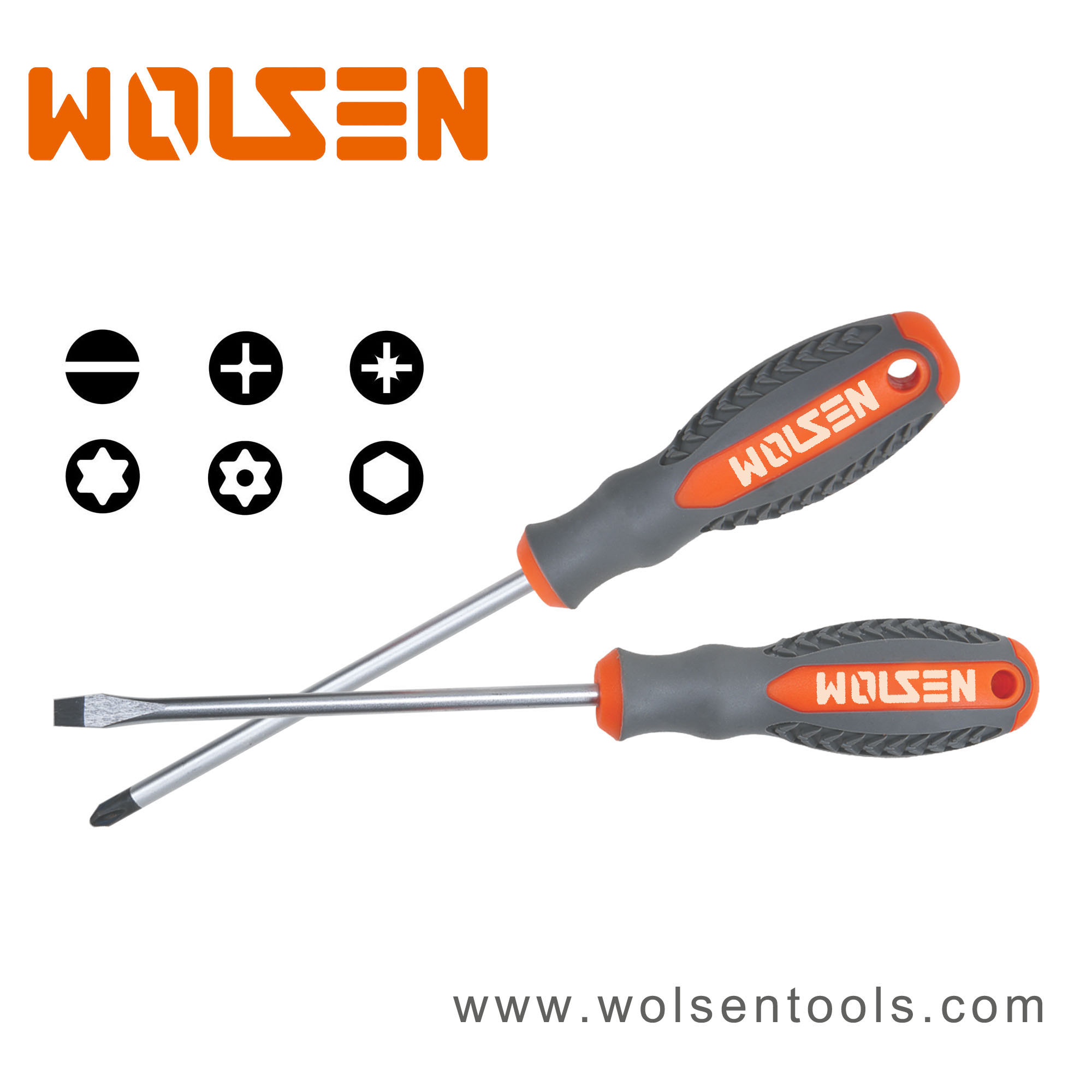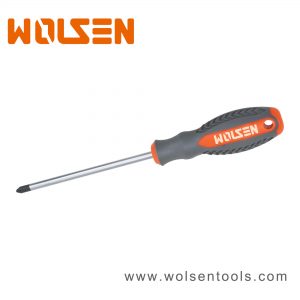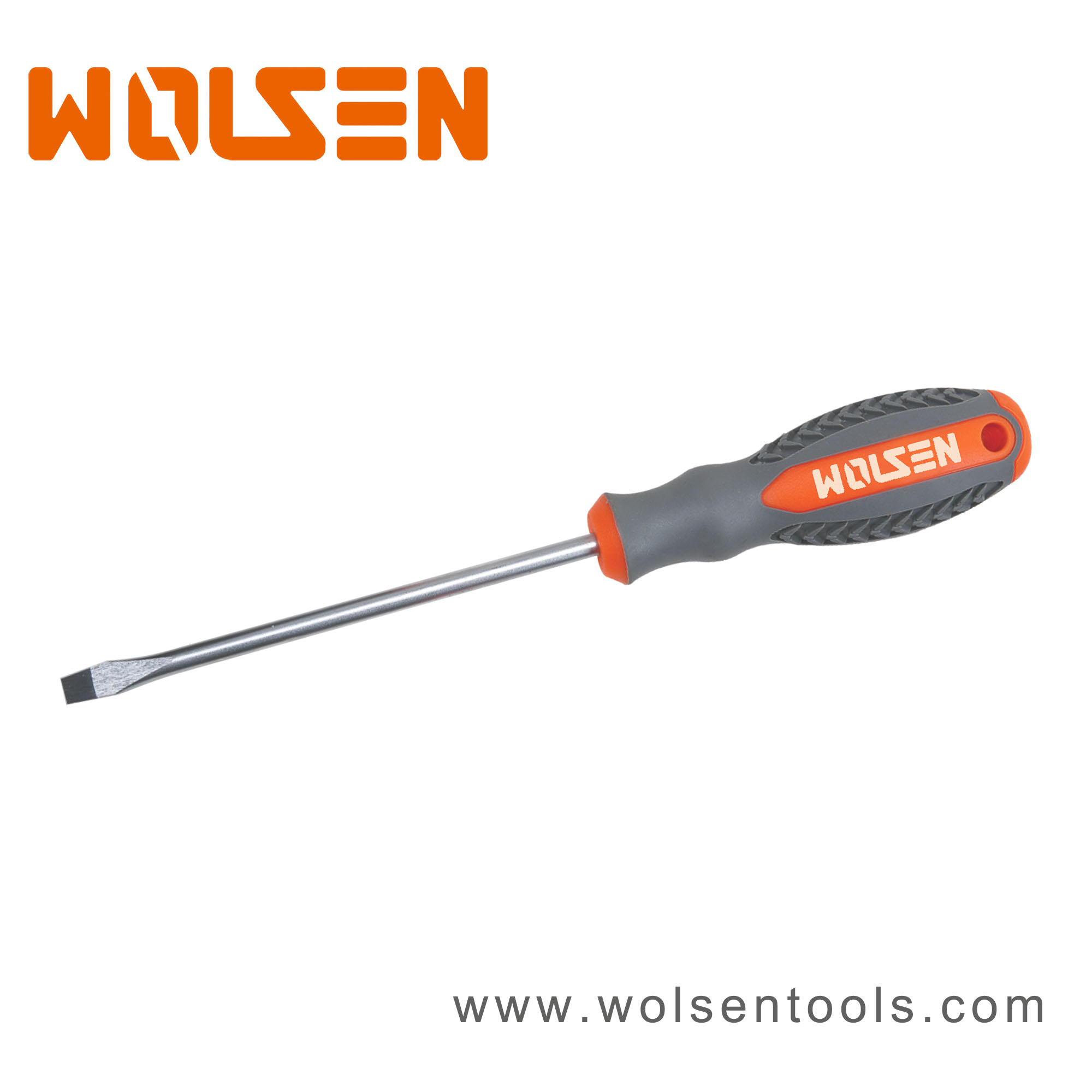
Slotted Screwdriver
Item No.: 2001
Drive Type: Slot Drive
Rod Materil: Chrome Vanadium Steel
Surface Treatment: Chrome Plated
Tip: Magnetic Oxide Black Tip
Handle: Two-component Comfortable Grip, Anti-Roll Handle
Packaging: Plastic Hanger
| STOCK NO. | BLADE SIZE | OVER LENGTH | QTY./INNER BOX | QTY./CARTON |
| 200101 | 2.5x75mm | 164mm | 12 | 240 |
| 200102 | 3.0x75mm | 164mm | 12 | 240 |
| 200103 | 3.5x75mm | 164mm | 12 | 240 |
| 200104 | 4.0x75mm | 164mm | 12 | 240 |
| 200105 | 4.0x100mm | 189mm | 12 | 240 |
| 200106 | 5.5x75mm | 164mm | 12 | 240 |
| 200107 | 5.5x100mm | 189mm | 12 | 240 |
| 200108 | 6.5x100mm | 200mm | 12 | 180 |
| 200109 | 6.5x125mm | 225mm | 12 | 180 |
| 200110 | 6.5x180mm | 250mm | 12 | 180 |
| 200111 | 8.0x150mm | 260mm | 12 | 120 |
| 200112 | 8.0x200mm | 310mm | 12 | 120 |
Screwdriver and Types
What is Screwdriver?
A screwdriver is used for tightening or loosening the screw. A round rod with a flat end, having a handle at the other end is called a screwdriver. The length of a screwdriver is measured excluding the handle. The length of a screwdriver varies from 50 millimeters i.e. 2” to 18”. A screwdriver has three main parts, as shown in the figure.
Parts of Screwdriver
Following are the main parts of a screwdriver:
- Handle
- Shank
- Blade
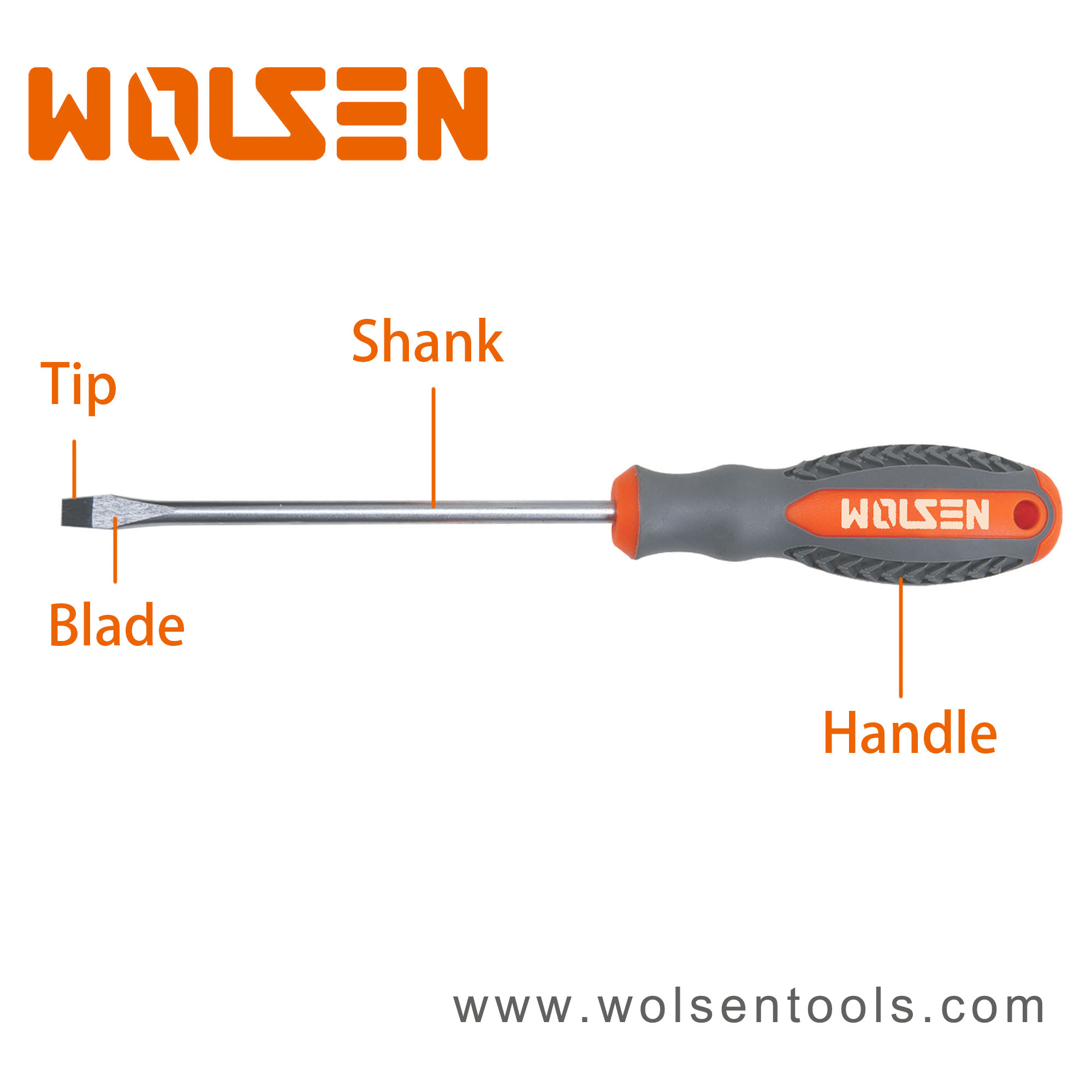
1. Handle
Handle, generally wooden or plastic handles are fixed to the screwdrivers. In order to save the wooden handle from being broken, an iron is fixed to the handle.
2. Shank
The middle part between the blade and the handle is called the shank. On its lower part tip or blade is made.
On the upper part either there is a hole through which a wire is passed or this end is made flat so that when this part is fixed to handle it does not allow the shank to move separately. These are generally made of carbon steel.
3. Blade
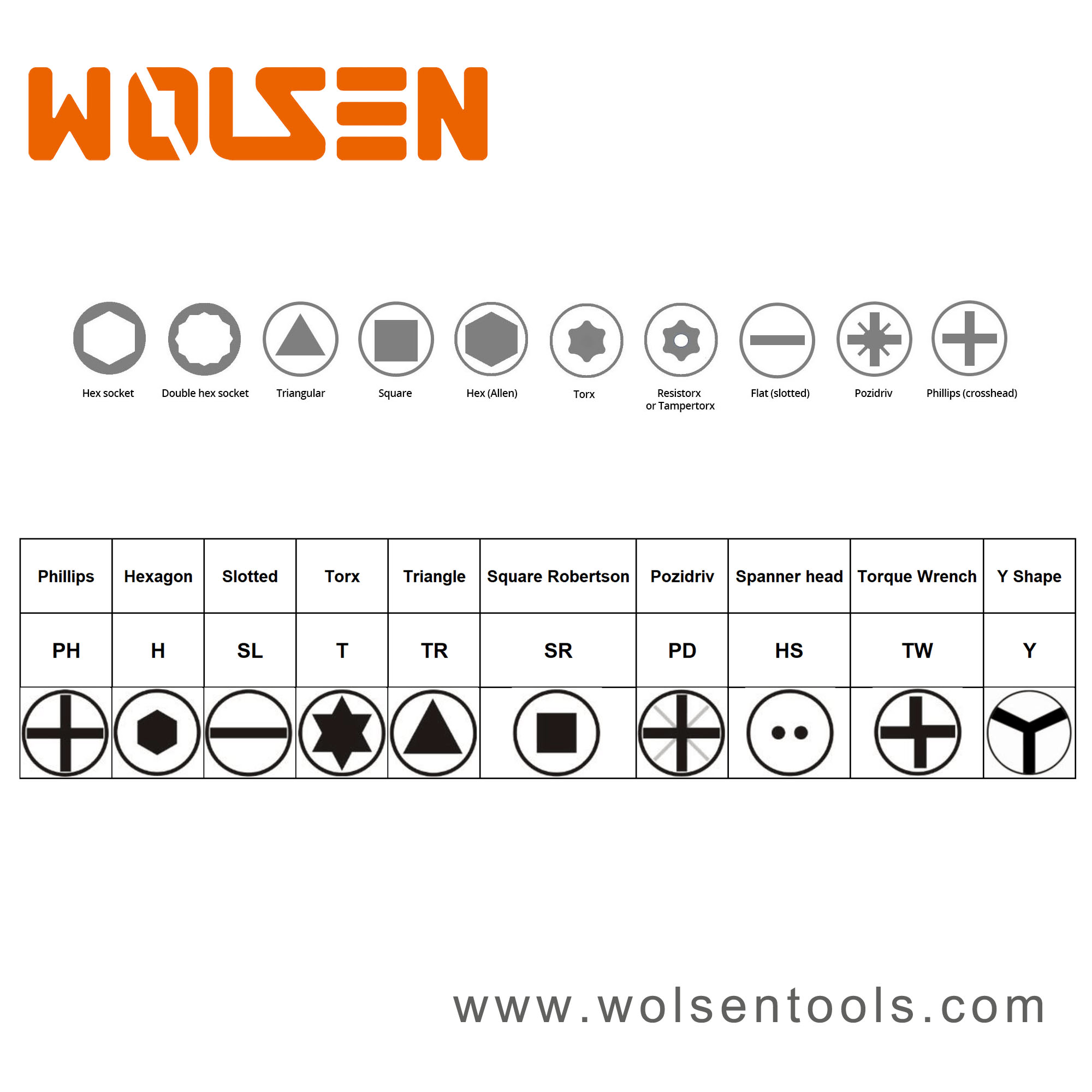
Blade is the lower part of the shank. It is also known as tip. This part is hardened and tempered.
Types of Screwdrivers
Following are the types of screwdrivers, which are described below:
1. Flat Head or Slotted Head
As its name indicates these types of screwdrivers are used for tightening or loosening different types of screws. These are available in small as well as larger sizes.
Flathead screwdrivers have a handle of wood or plastic fixed to them. According to needs, there are light-duty screwdrivers or heavy-duty screwdrivers. They have a flat tip.
2. Philips
The tip of these types of screwdrivers is different from that of others. This tip is pointed and is made after cutting four flutes. Philips screwdrivers are used where the screw has T cross-shaped groove at their heads. These screws are available in varying numbers measurements.
3. Torx
Torx screwdrivers are very common and are often used by automotive engineers. Sometimes they are also called star tips by an engineer. This driver has a star-shaped tip with 6 round lobes.
A Torx screwdriver has a low radial force due to the spherical geometry of the lobes, which improves the life of the screw and the screwdriver bit. Unlike Philips or Pozidriv screwdrivers, even on power devices with high driving speeds, too much torque can be transferred with no chance of equipment slipping, which makes it safer to use.
Torx-type screwdrivers come in a variety of sizes and use a numbering system such as T8, T10, T15, T25, etc. to determine the tip size. As the number increases, the tooltip size increases.
4. Robertson or Square Screwdriver
The square screwdriver is also known as the Robertson screwdriver. A Canadian invented this screwdriver. Engagement of a fairly tapered square-shaped opening screw with a square projection, which involves no angle, neglects the cam-out effect, thus improving centralization.
A slight taper shape in front of the tool provides a good locking with screws and hence makes it more suitable for use. These types of screwdrivers were first used by the Ford Motor Company for industrial purposes, as these drivers speed up production, reduce losses, and are highly reliable.
5. Pozidriv
Unlike the Phillips screwdriver, the pozidriv screwdriver has two cross marks that are offset at an angle of 45 degrees. These are widely used in European countries.
This shape does not completely overcome the cam-out effect but gives better resistance to slipping and provides more stability than the Phillip screwdriver. So, it is used for use that requires huge torque for tightening of the screw.
6. Hex or Hexagonal Screwdriver
It has six straight portions like a hexagon. These are often used to fasten bolts instead of screws. You may be seen these bits in your bitcoin box to tighten or lose hex bolts, nuts, and screws.
There is no sliding or cam-out effect when driving it, so the most powerful driver tools can be fitted with hex arranging bits and thus, it produces faster and with less error.
7. Offset
The Offset screwdrivers have also a flat blade. But no handle is used in these screwdrivers. Their shank is turned at 90 angles at both ends and bits are made on both ends. In cases of narrow or slanting spaces, where ordinary flat screwdriver cannot work, this offset screwdriver is used. It is shown in the figure.
8. Watchmaker
Watchmaker screwdrivers are available in sets. In a set there are six screwdrivers, having number markings from 0 to 5. The smaller the number of the screwdriver, the smaller and thinner is its bit. In place of the handle, a cap is fixed to the shank.
The cap is fixed to the shank in such a way that both cap and the shank can be moved independently. For tightening or loosening a screw, the tip is placed at the head of the screw, and the cap is pressed with one finger, while with other fingers shank is rotated. A watchmaker screwdriver can be used in all kinds of instruments and watches. In appearance, it looks as shown in the figure.
9. Clutch Head
These types of screwdrivers are used throughout the automobile industry and are commonly used in older GM vehicles. The clutch head screwdriver is also known as bow-tie drivers, these drivers are used to work screws that have a bow-tie-shaped slot.
The clutch screwdriver begins with higher torque and can resist greater turning force. But, this type of screw can also be tight and loose slotted drivers. There is another safe way that it can be screwed by a slotted driver but not loosened.
10. Frearson
The tip of these types of screwdrivers is provided with a sharp point, unlike Philip Driver, it has bluntly rounded points. In addition, the angle of the tip is more like 45 degrees than the Phillip drivers. This driver is used on nautical equipment.
The Frearson driver, also known as Reed or Prince, is pretty similar to the Philippe screwdriver in design, with some changes. The different shape allows the driver to take out higher torque than the Phillips and to operate on Frearson screws of all sizes as well as a large number of Phillip screws.
11. Tri-point
These types of screwdrivers are very familiar in the electronic industry and tech giants such as Nintendo and Apple apply them in their phones, gaming systems, and other devices.
The tri-point driver makes a tip that has three blades set at an angle of 120 degrees, which is Y-shaped. So, It is also known as 3-prong or Y-tip drivers. Tri-point drivers also have safety issues only that come with tri-angle driver compatibility with hex drivers.
12. Tri-angle
These types of screwdrivers were mostly used in the toy, electronics, and appliance industries and were added to improve safety. But, a hex screwdriver can also hold TA screws, so many DIY kits do not have tri-angle drivers.
It is also known as three-angle screwdrivers. It has a triangle-shaped tip for slotting on the screw head with a triangle shape.
13. Tri-wing
The tip of the tri-wing drivers resembles that of some pinwheels and is used to operate on screws that have triangular sockets with three wing sizes. Because these screws have such a different slot, it is difficult to remove them without a tri-wing driver.
Tri-wing screwdrivers are costly and not easily available like other drivers. These drivers were previously manufactured for use in aerospace engineering, but now you can easily found them in home electronics.
14. Carpenter
The carpenter screwdriver is made of a round rod and flat tip. Its handle is made flat from two sides (as shown in the figure). This enables the worker to exert full force or the screwdriver.
15. Bolster
The bolster screwdriver has a type of nut, which is welded to the top of the shaft under the handle. If a screw is tightened on a surface, you can loosen it by applying additional torque by turning the welded nut with the help of a wrench.
The bolster screwdriver are able to withstand maximum pressure loads in any conditions.
16. Multipurpose Screwdriver
The multipurpose screwdriver has a shank with a hexagonal hole at the end where it can fit a variety of drivers on both sides, with drivers or depending on the use of the set. Because they offer more versatility and economy of space, they are a very common toolset among those who have only basic requirements.
17. Special Types of Screwdrivers
Many of screwdrivers also come with changes to their handles and shanks. The optional design helps to eject more torque and offer enough clearance.
Following are the some of special types of screwdrivers:
(1). Electrical Type
These types of screwdrivers are charged by electricity, which means that you do not need to use your muscles to exert torque. It can work a screw easily and quickly, especially for those with a broken head. Therefore, it is also known as power screwdrivers or screw guns.
(2). Torque Type
It is generally known for its application on cars, but the thing that pressure requires equipment. This type of screwdrivers can offer highly specific uses including everything from military repairs to aircraft.
(3). Corded Type
This type of screwdriver comes with an electric cord. But, they are not very common as they need to be transported to a nearby power source. Still, they provide a constant power supply and are highly efficient.
(4). Cordless Type
This type of screwdriver is provided with a rechargeable battery which means that they come with the advantages of both electrical and battery-powered screwdrivers.
Accidentally, this makes them heavier and as the battery charge decreases, they also lose torque.
(5). Magnetic Type
It has a magnetic tip that holds the screw, allowing you to insert the screw in or out with just one hand. More and more manual screwdrivers are now being manufactured with magnetic tips.
(6). Jeweller’s Type
They are precision instruments that employ small screws on pocket watches and eyeglasses. It is also known as a watch or eyeglass driver. They are usually Philips and flat head screwdrivers.
(7). Battery Type
This type of screwdriver is operated with small batteries, which means they come in a compact design. Although it is not as powerful as other screwdrivers, it can easily fit into your toolbox.
(8). Ratchet Type
In these types of screwdrivers, a spring or ratchet is fitted to the handle. There is a button on its handle. When this button is pressed, the shank of the ratchet screw starts revolving through the spring.
When the button is left free, again the shank comes to its original position. With its help screws can be quickly tightened or loosened.
Conclusion
As you know, A typical simple screwdriver has a handle and shaft that the user attaches to the screw head before turning the handle used for tightening or loosening screws.
So now, we hope that we have cleared all your doubts about the screwdrivers. If you have still any doubts about the “Types of Screwdrivers” you can contact us or ask in the comments.
What is a Screwdriver?
A screwdriver is a tool, manual or powered, used for turning screws. A typical simple screwdriver has a handle and a shaft, ending in a tip the user puts into the screw head before turning the handle. This form of the screwdriver has been replaced in many workplaces and homes with a more modern and versatile tool, a power drill, as they are quicker, easier, and can also drill holes. The shaft is usually made of tough steel to resist bending or twisting. The tip may be hardened to resist wear, treated with a dark tip coating for improved visual contrast between tip and screw—or ridged or treated for additional ‘grip’. Handles are typically wood, metal, or plastic and usually hexagonal, square, or oval in cross-section to improve grip and prevent the tool from rolling when set down. Some manual screwdrivers have interchangeable tips that fit into a socket on the end of the shaft and are held in mechanically or magnetically. These often have a hollow handle that contains various types and sizes of tips, and a reversible ratchet action that allows multiple full turns without repositioning the tip or the user’s hand.
A screwdriver is classified by its tip, which is shaped to fit the driving surfaces—slots, grooves, recesses, etc.—on the corresponding screw head. Proper use requires that the screwdriver’s tip engage the head of a screw of the same size and type designation as the screwdriver tip. Screwdriver tips are available in a wide variety of types and sizes. The two most common are the simple ‘blade’-type for slotted screws, and Phillips, generically called “cross-recess”, “cross-head”, or “cross-point”.
A wide variety of power screwdrivers ranges from a simple ‘stick’-type with batteries, a motor, and a tip holder all inline, to powerful “pistol” type VSR (variable-speed reversible) cordless drills that also function as screwdrivers. This is particularly useful as drilling a pilot hole before driving a screw is a common operation. Special combination drill-driver bits and adapters let an operator rapidly alternate between the two. Variations include impact drivers, which provide two types of ‘hammering’ force for improved performance in certain situations, and “right-angle” drivers for use in tight spaces. Many options and enhancements, such as built-in bubble levels, high/low gear selection, magnetic screw holders, adjustable-torque clutches, keyless chucks, ‘gyroscopic’ control, etc., are available.
History
The earliest documented screwdrivers were used in the late Middle Ages. They were probably invented in the late 15th century, either in Germany or France. The tool’s original names in German and French were Schraubenzieher [circular reference] (screwpuller) and tournevis (turnscrew), respectively. The first documentation of the tool is in the medieval Housebook of Wolfegg Castle, a manuscript written sometime between 1475 and 1490. These earliest screwdrivers had pear-shaped handles and were made for slotted screws (diversification of the many types of screwdrivers did not emerge until the Gilded Age). The screwdriver remained inconspicuous, however, as evidence of its existence throughout the next 300 years is based primarily on the presence of screws.
Screws were used in the 15th century to construct screw-cutting lathes, for securing breastplates, backplates, and helmets on medieval jousting armor—and eventually for multiple parts of the emerging firearms, particularly the matchlock. Screws, hence screwdrivers, were not used in full combat armor, most likely to give the wearer freedom of movement.
The jaws that hold the pyrites inside wheellock guns were secured with screws, and the need to constantly replace the pyrites resulted in a considerable refinement of the screwdriver. The tool is more documented in France, and took on many shapes and sizes, though all for slotted screws. There were large, heavy-duty screwdrivers for building and repairing large machines, and smaller screwdrivers for refined cabinet work.
The screwdriver depended entirely on the screw, and it took several advances to make the screw easy enough to produce to become popular and widespread. The most popular door hinge at the time was the butt-hinge, but it was considered a luxury. The butt-hinge was handmade, and its constant motion required the security of a screw.
Screws were very hard to produce before the First Industrial Revolution, requiring the manufacture of a conical helix. The brothers Job and William Wyatt found a way to produce a screw on a novel machine that first cut the slotted head, and then cut the helix. Though their business ultimately failed, their contribution to low-cost manufacturing of the screw ultimately led to a vast increase in the screw and the screwdriver’s popularity. The increase in popularity gradually led to refinement and eventually diversification of the screwdriver. Refinement of the precision of screws also significantly contributed to the boom in production, mostly by increasing its efficiency and standardizing sizes, important precursors to industrial manufacture.
Canadian P.L. Robertson, though he was not the first person to patent the idea of socket-head screws, was the first to successfully commercialize them, starting in 1908. Socket screws rapidly grew in popularity, and are still used for their resistance to wear and tear, compatibility with hex keys, and ability to stop a power tool when set. Though immensely popular, Robertson had trouble marketing his invention to the newly booming auto industry, for he was unwilling to relinquish his patents.
Meanwhile, in Portland, Oregon, Henry F. Phillips patented his own invention, an improved version of a deep socket with a cruciform slot, today known as the Phillips Screw. Phillips offered his screw to the American Screw Company, and after a successful trial on the 1936 Cadillac, it quickly swept through the American auto industry. With the Industrial Revival at the end of the Great Depression and the upheaval of World War II, the Phillips screw quickly became, and remains, the most popular screw in the world. A main attraction for the screw was that conventional slotted screwdrivers could also be used on them, which was not possible with the Robertson Screw.
Gunsmiths still call a screwdriver a turnscrew, under which name it is an important part of a set of pistols. The name was common in earlier centuries, used by cabinetmakers, shipwrights, and perhaps other trades. The cabinetmaker’s screwdriver is one of the longest-established handle forms, somewhat oval or ellipsoid in cross-section. This is variously attributed to improving grip or preventing the tool rolling off the bench. The shape has been popular for a couple of hundred years. It is usually associated with a plain head for slotted screws, but has been used with many head forms. Modern plastic screwdrivers use a handle with a roughly hexagonal cross-section to achieve these same two goals, a far cry from the pear-shaped handle of the original 15th-century screwdriver.
Handle
The handle and shaft of screwdrivers have changed considerably over time. The design is influenced by both purpose and manufacturing requirements. The “Perfect Pattern Handle”[further explanation needed] screwdriver was first manufactured by HD Smith & Company, which operated from 1850 to 1900. Many manufacturers adopted this handle design. At the time, the “flat bladed” screw type was prevalent and was the fastener with which they were designed to be used. Another popular design was composed of drop-forged steel with riveted wood handles.
The shape and material of many modern screwdriver handles are designed to fit comfortably in the user’s hand, for user comfort and to facilitate maximum control and torque. Designs include indentations for the user’s fingers, and surfaces of a soft material such as thermoplastic elastomer to increase comfort and grip. Composite handles of rigid plastic and rubber are also common. Many screwdriver handles are not smooth and often not round, but have flats or other irregularities to improve grip and to prevent the tool from rolling when on a flat surface.
Some screwdrivers have a short hexagonal section at the top of the blade, adjacent to the handle, so that a ring spanner or open wrench can be used to increase the applied torque. Another option are “cabinet” screwdrivers which are made of flat bar stock and while the shaft may be rounded, will have a large flat section adjacent to the handle which a wrench (often an adjustable) may be used on for additional leverage. The offset screwdriver has a handle set at right angles to the small blade, providing access to narrow spaces and giving extra torque.
Drive tip
Screwdrivers come in a large range of sizes to accommodate various screws—from tiny jeweller’s screwdrivers up. A screwdriver that is not the right size and type for the screw may damage the screw in the process of tightening it.
Some screwdriver tips are magnetic, so that the screw (unless non-magnetic) remains attached to the screwdriver without requiring external force. This is particularly useful in small screws, which are otherwise very difficult to attempt to handle. Many screwdriver designs have a handle with a detachable tip (the part of the screwdriver that engages the screw), called bits as with drill bits. This provides a set of one handle and several bits that can drive a variety of screw sizes and types.
Drive types
The tool used to drive a slotted screw head is called a standard, common blade, flat-blade, slot-head, straight, flat, flat-tip, or “flat-head” screwdriver. This last usage can be confusing, because the term flat-head also describes a screw with a flat top, designed to install in a countersunk hole. Furthermore, the term implies that a screwdriver has a “head”; it does not. Such a flat-headed screw may have a slotted, cross, square recessed, or combination head. Before the development of the newer bit types, the flat-blade was called the “Common-Blade”, because it was the most common one. Depending on the application, the name of this screwdriver may differ. Within the automotive/heavy electric industries, it is known as a “flat head screwdriver”; within the avionics and mining industries, it is known as a “standard screwdriver”. Though there are many names, the original device from 1908 was known as a “flat-head screw turner”.
Among slotted screwdrivers, variations at the blade or bit end involve the profile of the blade as viewed face-on (from the side of the tool). The more common type is sometimes called keystone, where the blade profile is slightly flared before tapering off at the end, which provides extra stiffness to the workface and makes it capable of withstanding more torque. To maximize access in space-restricted applications, the cabinet variant screwdriver blade sides are straight and parallel, reaching the end of the blade at a right angle. This design is also frequently used in jeweler’s screwdrivers.
Many textbooks and vocational schools instruct mechanics to grind down the tip of the blade, which, due to the taper, increases its thickness and consequently allows more precise engagement with the slot in the screw. This approach creates a set of graduated slotted screwdrivers that fit a particular screw for a tighter engagement and reduce screw head deformation. However, many better-quality screwdriver blades are already induction-hardened (surface heat-treated), and tip grinding after manufacture compromises their durability. Thus, it is best to select a tip made to fit precisely to begin with, and avoid weakening the factory heat-treatment.
Phillips screwdrivers come in several standard sizes, ranging from tiny “jeweler’s” to those used for automobile frame assembly—or #000 to #4 respectively. This size number is usually stamped onto the shank (shaft) or handle for identification. Each bit size fits a range of screw sizes, more or less well. Each Phillips screwdriver size also has a related shank diameter. The driver has a 57° point and tapered, unsharp (rounded) flutes. The #1 and smaller bits come to a blunt point, but the #2 and above have no point, but rather a nearly squared-off tip, making each size incompatible with the other.
The design is often criticized for its tendency to cam out at lower torque levels than other “cross head” designs, an effect caused by the tapered profile of the flutes which makes them easier to insert into the screw than other similar styles. There has long been a popular belief that this was actually a deliberate feature of the design. Evidence is lacking for this specific narrative and the feature is not mentioned in the original patents. However, a subsequent refinement to the original design described in US Patent #2,474,994 describes this feature.
Robertson, also known as a square, or Scrulox screw drive has a square-shaped socket in the screw head and a square protrusion on the tool. Both the tool and the socket have a taper, which makes inserting the tool easier, and also tends to help keep the screw on the tool tip without the user needing to hold it there. (The taper’s earliest reason for being was to make the manufacture of the screws practical using cold forming of the heads,[16] but its other advantages helped popularize the drive.) Robertson screws are commonplace in Canada, though they have been used elsewhere, and have become much more common in other countries in recent decades. Robertson screwdrivers are easy to use one-handed, because the tapered socket tends to retain the screw, even if it is shaken. They also allow for the use of angled screw drivers and trim head screws. The socket-headed Robertson screws are self-centering, reduce cam out, stop a power tool when set, and can be removed if painted over or old and rusty. In industry, they speed up production and reduce product damage. One of their first major industrial uses was the Ford Motor Company’s Model A & Model T production. Henry Ford found them highly reliable and saved considerable production time, but he couldn’t secure licensing for them in the United States, so he limited their use solely to his Canadian division. Robertson-head screwdrivers are available in a standard range of tip sizes, from 1.77mm to 4.85mm.
Reed and Prince, also called Frearson, is another historic cross-head screw configuration. The cross in the screw head is sharper and less rounded than a Phillips, and the bit has 45° flukes and a sharper, pointed end. Also, the Phillips screw slot is not as deep as the Reed and Prince slot. In theory, different size R&P screws fit any R&P bit size.
Pozidriv and the related Supadriv are widely used in Europe and most of the Far East.[22] While Pozidriv screws have cross heads like Phillips and are sometimes thought effectively the same, the Pozidriv design allows higher torque application than Phillips. It is often claimed that they can apply more torque than any of the other commonly used cross-head screwdriver systems, due to a complex fluting (mating) configuration.
Japanese Industrial Standard (JIS) cross-head screwdrivers are still another standard, often inaccurately called Japanese Phillips. Compatible screw heads are usually identifiable by a single depressed dot or an “X” to one side of the cross slot. This is a screw standard throughout the Asia market and Japanese imports. The driver has a 57° point with a flat tip.
Many modern electrical appliances, if they contain screws, use screws with heads other than the typical slotted or Phillips styles. Torx is one such pattern that has become widespread. It is a spline tip with a corresponding recess in the screw head. The main cause of this trend is manufacturing efficiency: Torx screwdriver tips do not slip out of the fastener as easily as would a Phillips or slotted driver. (Slotted screws are rarely used in mass-produced devices, since the driver is not inherently centered on the fastener.)
Non-typical fasteners are commonplace in consumer devices for their ability to make disassembly more difficult, which is seen as a benefit for manufacturers but is considered a disadvantage by users than if more common head types were used. In microwave ovens, such screws deny casual access to the high-power kilovolt electrical components, which are very dangerous.
However, Torx and other drivers have become widely available to the consumer due to their increasing use in the industry. Some other styles fit a three-pointed star recess, and a five-lobed spline with rounded edges instead of the square edges of the Torx. This is called a Pentalobe.
Specialized patterns of security screws are also used, such as the Line Head (LH) style by OSG System Products, Japan, as used in many Nintendo consoles, though drivers for the more common security heads are, again, readily available. Another type of security head has smooth curved surfaces instead of the slot edges that would permit loosening the screw; it is found in public rest room privacy partitions, and cannot be removed by conventional screwdrivers.
Variations
Torque screwdrivers
Screwdrivers are available—manual, electric, and pneumatic—with a clutch that slips at a preset torque. This helps the user tighten screws to a specified torque without damage or over-tightening. Cordless drills designed to use as screwdrivers often have such a clutch.
Powered screwdrivers
Interchangeable bits allow the use of powered screwdrivers, commonly using an electric or air motor to rotate the bit. Cordless drills with speed and torque control are commonly used as power screwdrivers.
Ratcheting screwdrivers
Some manual screwdrivers have a ratchet action whereby the screwdriver blade locks to the handle for clockwise rotation, but uncouples for counterclockwise rotation when set for tightening screws—and vice versa for loosening.
Spiral ratchet screw drivers, often colloquially called Yankee screwdrivers (a brand name), provide a special mechanism that transforms linear motion into rotational motion. Originally the “Yankee” name was used on all tools sold by the North Brothers Manufacturing Company but later, after Stanley purchased the company, it became synonymous with only this type of screwdriver. The user pushes the handle toward the workpiece, causing a pawl in a spiral groove to rotate the shank and the removable bit. The ratchet can be set to rotate left or right with each push, or can be locked so that the tool can be used like a conventional screwdriver. One disadvantage of this design is that if the bit slips out of the screw, the resultant sudden extension of the spring may cause the bit to scratch or otherwise damage the workpiece.
Once very popular, versions of these spiral ratchet drivers using proprietary bits have been largely discontinued by manufacturers such as Stanley. Some companies now offer a modernized version that uses standard 1⁄4-inch hex shank power tool bits. Since a wide variety of drill bits are available in this format, the tool can do double duty as a “push drill” or Persian drill.

